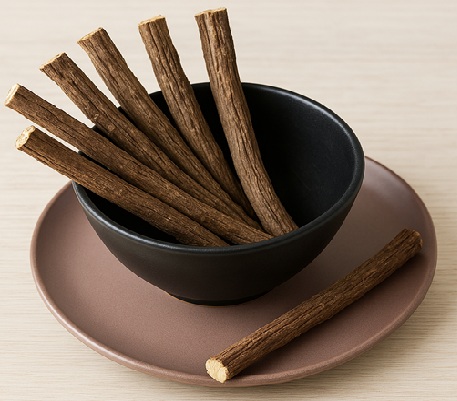Licorice Root

Licorice Root (Gan Cao): A Harmonizing Herb for Qi, Digestion, and Detoxification
Introduction
Licorice root, known as Gan Cao (甘草) in Traditional Chinese Medicine (TCM), is a foundational herb revered for its harmonizing nature, gentle sweetness, and wide range of therapeutic effects. Used in more TCM formulas than any other herb, it enhances the effectiveness of other ingredients while also soothing the digestive system, tonifying the Spleen, and clearing heat or toxins. Whether used alone or in synergy with other herbs, licorice root is a mild yet powerful botanical ally.
What Is Licorice Root?
Gan Cao refers to the root of Glycyrrhiza uralensis (Chinese licorice), though sometimes other Glycyrrhiza species are also used. In TCM, it is considered sweet and neutral to slightly warm in nature, and it enters all twelve meridians—especially the Heart, Lung, Spleen, and Stomach. Traditionally, Gan Cao is used to tonify qi, moisten the lungs, relieve spasms or pain, clear heat and toxicity, and moderate the harshness of stronger herbs in complex formulas. Its sweet flavor and flexible actions have made it one of the most respected and versatile herbs in the Chinese herbal tradition.
Health Benefits of Licorice Root
1. Tonifies Qi and Strengthens the Spleen
Licorice gently supports the body’s energy by strengthening the Spleen and augmenting qi. It’s often used for symptoms like fatigue, weakness, or poor appetite.
2. Moistens Lungs and Relieves Cough
Gan Cao helps moisten dry lungs and soothe sore throats, making it useful in dry coughs or lung heat conditions.
3. Relieves Spasms and Pain
It is often used to relieve muscular tension, abdominal cramps, or spasms in the gastrointestinal tract, especially when combined with other antispasmodic herbs.
4. Clears Heat and Detoxifies
Licorice is commonly used to treat skin sores, ulcers, or sore throats by clearing heat and removing toxins, both internally and topically.
5. Harmonizes Other Herbs and Formulas
One of Gan Cao’s most important roles is as a harmonizer. It balances the actions of other herbs in a formula, reduces potential toxicity, and enhances overall effectiveness.
How to Use Licorice Root
1. In Soups and Herbal Decoctions
Boil 3–9 grams of sliced dried licorice root with herbs such as astragalus, red dates, or ginger. Simmer for 20–40 minutes to extract its gentle sweetness and benefits.
2. In Herbal Teas
Licorice is often brewed into tea on its own or with calming herbs like chamomile or mint. A small amount (2–5 grams) can add natural sweetness and balance to a blend.
3. In Powder or Capsule Form
Licorice root powder or standardized extracts are convenient and widely used in TCM formulas and Western herbal blends. Always follow dosage guidelines, especially with long-term use.
Where to Buy Licorice Root
You can find Gan Cao at the following places:
-
Chinese herbal medicine shops
-
Asian grocery stores or herb apothecaries
-
Online retailers such as iHerb, Amazon, or specialty TCM websites
Look for:
-
Whole or sliced dried root with a golden-yellow interior
-
Organic or sulfite-free labeling
-
Lab-tested or certified products for purity and safety
Are There Any Side Effects?
While licorice is very safe in moderate amounts, long-term or high-dose use can lead to side effects such as water retention, elevated blood pressure, or low potassium levels. Individuals with high blood pressure, kidney disease, or heart conditions should consult a healthcare professional before use. Deglycyrrhizinated licorice (DGL) is a safer option for long-term or digestive use.
Conclusion
Licorice root, or Gan Cao, is a treasured herb in TCM for its soothing, balancing, and harmonizing properties. Whether tonifying qi, supporting the lungs, easing spasms, or enhancing herbal formulas, this versatile root plays a quiet yet essential role in maintaining health and harmony throughout the body.
FAQs
Can I use licorice root every day?
Yes, small amounts can be used daily in tea or formulas, but prolonged high-dose use should be monitored by a qualified practitioner.
What does licorice root taste like?
It has a naturally sweet, mild, and slightly earthy flavor that makes it pleasant in teas and decoctions.
Is licorice root safe for children?
Yes, in small amounts and under supervision. It is often included in pediatric TCM formulas for digestion, cough, or calming effects.

